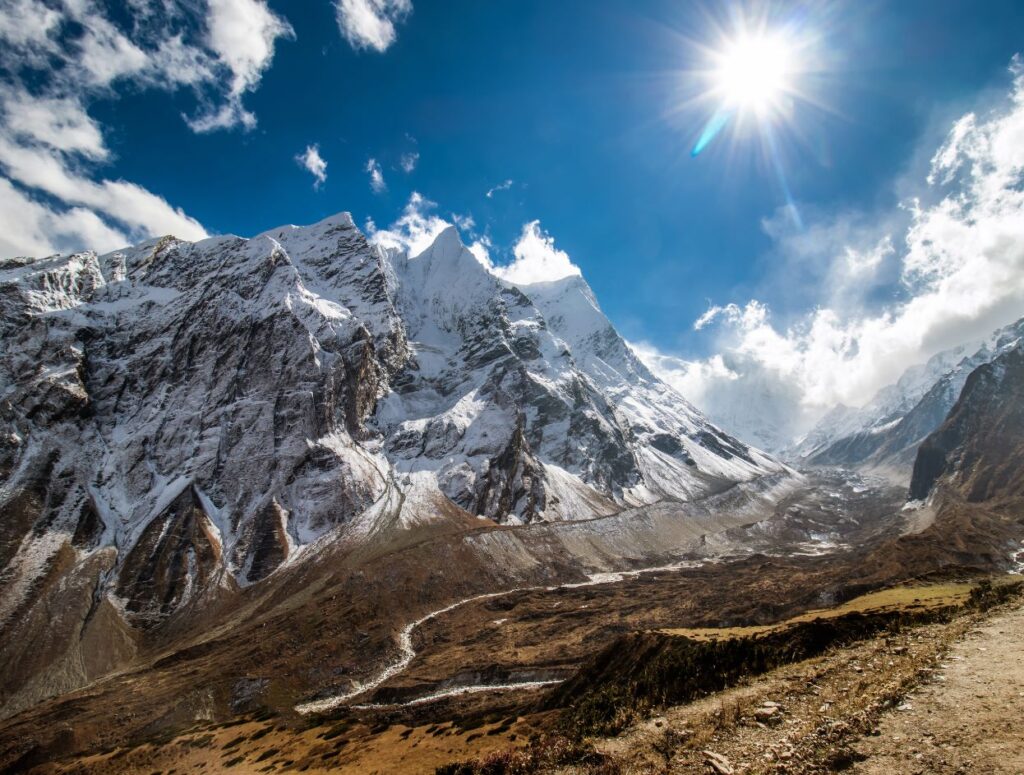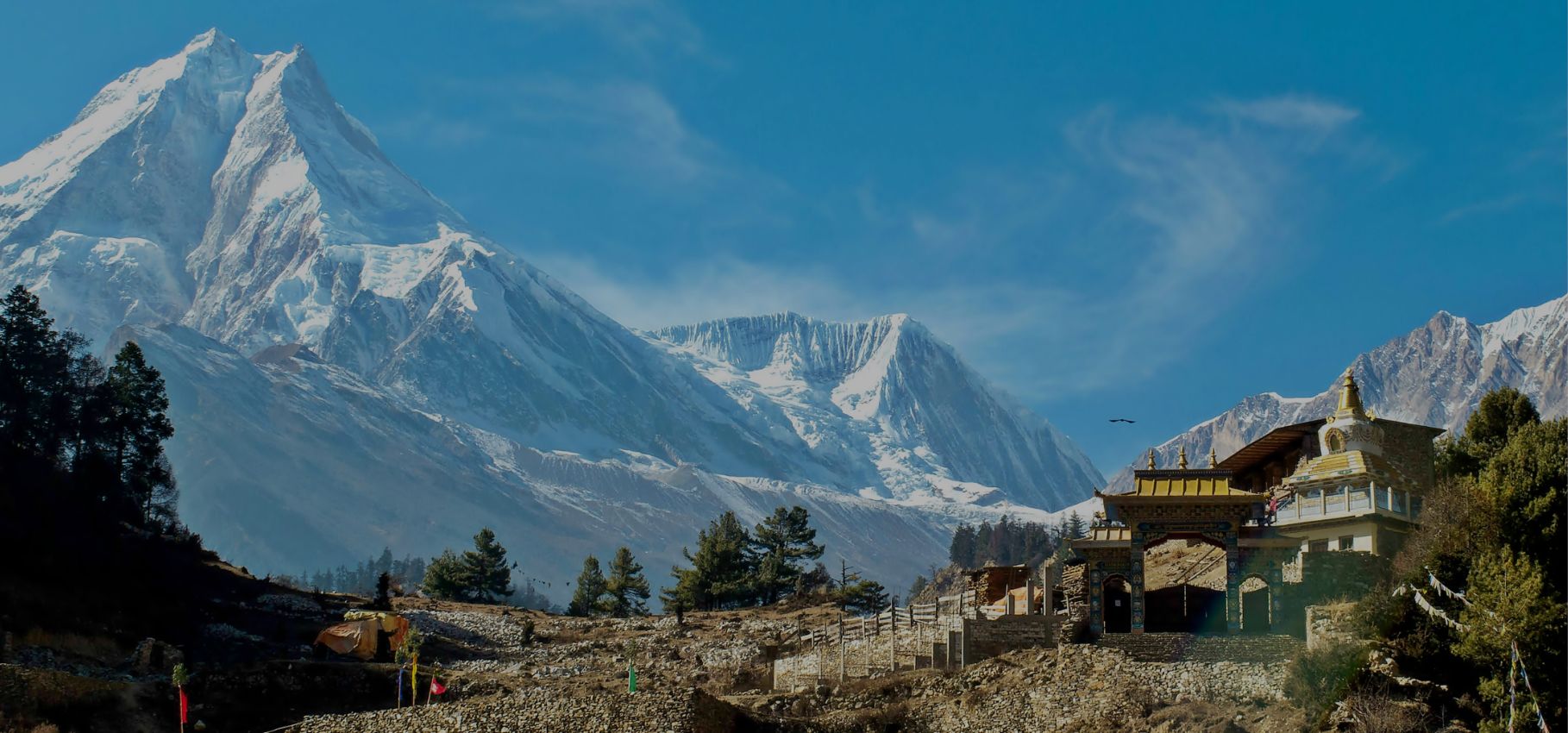31 Oct Mountain Childhood: How Kids in Manaslu Grow Up With Nature
In the magic and mystery of the Himalayas, where the fluttering prayer flags whisper the secrets of the entire region, children in the Manaslu region rise early. Their teacher is not the one in an ironed shirt, pants, and a Dhaka Topi; it’s the slopes, the streams, the yaks grazing, and Mother Nature herself.
The Mount Manaslu (8,163 m) watches over these children, day in and day out. This is a childhood not limited to screens or tablets, or to tidy suburban corners. This is a childhood spent in an altitude, in forest light, in the swirl of prayer flags, and yak bells.
Their childhood is shaped by the mountain itself, with all its demands, joys, and lessons.
For trekkers, the Manaslu region is normally a backdrop for excitement: majestic peaks, glacial valleys, ancient gompas, and remote monasteries. But behind the scenery are families, village kids, and lives woven into the landscape.
Kids in the Manaslu region grow up among nature. Their childhood is different from the urban childhood many of us know, and how a trekking traveller can recognise, respect, and even support that way of being.
Childhood in the Manaslu region
The Manaslu Circuit trekking region, formally the Manaslu Conservation Area, is a wide variety of ecological belts, ranging from subtropical hill country to glacial alpine valleys. Villages of Samagaon, Lho, Prok, and Tsum Valley villages stretch across this terrain, where children grow up in a culture determined by geography and tradition.
Tibetan influence can be seen in their culture and daily life. The customs, costumes, food, and housing from early childhood can be observed.
Because of the altitude, climate extremes, rugged geography, and relative remoteness, childhood here is not a picture-book kind of thing in the way many Western or urban children are used to.
Nature is present, active, demanding. The river that becomes treacherous when swollen by monsoon rains, the yak herd that must be herded, the forest that yields medicinal plants, these are part of their life and learning.
The children here wake with the first light of the sun, filtered through their modest home, and help their parents fetch water from a spring, clean the house, or gather firewood before joining their family or parents in the fields or in village labor.
Their “playground” is moraines, riverbanks, and grasslands dotted with rhododendron flowers. They spend their “after-school” helping siblings with domestic work or joining elderly relatives on trekking-guide errands or yak herding.

How nature weaves into childhood
In Manaslu villages, childhood is not separated from nature; it is immersed in it. Here’s what a normal day of a child in Manaslu looks like:
– Morning light and movement: The sun rises late in valleys; children may accompany older siblings or parents to the spring, clearing a path of snow or frost in early spring.
– Work and environment: Firewood foraging involves going into the forest, observing tree species, and crossing streams with caution to avoid slipping. Yak herding means being alert to terrain changes, stream crossings, and altitude effects.
– Seasons and schooling: The monsoon brings distinct routines, and a cold winter means snow-covered trails and fewer visitors, fewer export opportunities for the family. The children adapt accordingly.
– Nature and culture in community: Festivals like Lhosar or local Buddhist ceremonies usually take place outdoors, at stupas or courtyards, with a mountainous backdrop in the background. Nature’s power and ritual are instilled in children at a young age.
In this way, kids absorbing the steep slopes and the buzz of spring meadows are learning resilience, navigation, ecological awareness, and community interdependence. They often become quietly capable in terrain and weather where many adults would struggle.
The school of the wild
If one were to list the “curriculum” of the mountain childhood in Manaslu, it might look like this:
| Skill / Lesson | How it’s taught in the mountains | Why it matters |
|---|---|---|
| Terrain awareness | Walking for hours on uneven trails, helping carry loads, fording streams | Builds physical strength, spatial sense, risk-awareness |
| Ecological literacy | Knowing herbs, streams, yak tracks, weather signs | Promotes respect for the environment and resourcefulness |
| Weather and seasonal adaptation | Knowing when snow comes, when paths freeze, when landslides are likely | Builds resilience and caution |
| Cultural and spiritual grounding | Living among monasteries, prayer flags, and local ritual in the midst of nature | Instils identity, continuity, respect |
| Community interdependence | Helping family, neighbours, visitors (trekkers) | Fosters cooperation, practical empathy |
| Global awareness (via trekking) | Interactions with visitors from around the world, guiding roles | Opens vistas, opportunity, but still grounded locally |
If one were to list the “curriculum” of the mountain childhood in Manaslu, it might look like this: These “lessons” are not school-based; they’re by experience. A child might help move a bundle of heavy wood and feel proud. Or they might go with a villager as he guides a trekking party across the Larkya La pass.
Or they could watch the birds in the rhododendron woods and know the names of the birds (or at least those that appear in the village). Piled up over time, such experience gives them a rich “mountain education.”
Challenges and opportunities
Naturally, it is not always poetic to be brought up in the mountains. In Manaslu, the children face real challenges. Not many people have access to secondary education; the area is remote and thus has fewer amenities. The challenges of altitude, weather, and remoteness place restrictions.
An IUCN-Nepal report indicates that the middle schools, hostels, and non-formal education in upper Gorkha (where Manaslu is situated) are in urgent need.
Similarly, in the case of families that depend on tourism (guiding, guesthouses), the declines or a change of regulations impacts incomes and consequently schooling and leisure time of children. The very feature which gave them birth, mountains, altitude, isolation, limits choice.
Yet, there are opportunities. Trekking tourism is an income earner, a source of employment, and a cultural exchange. A child may become a carrier or shepherd, can study English, meet strangers, and open his eyes to the outside world.
The companies, such as the Himalayan Masters operating in the area, contribute to the promotion of responsible tourism, training of the local youth, and sustainable livelihoods.

How trekking visitors can support and respect mountain childhood
Going on the Manaslu region trek, think about how your presence cuts through the lives of local children. These are considerate ways of making a positive change and not making a mess:
– Use local guides or porters in the villages you pass through; this provides income and stability for local children’s families.
– Do not mess up the routines of the children: they might be serving their families and not just there to entertain you.
– Always seek consent when taking photographs of children- some families do not want to be in the spotlight.
– Carry a small present of books, pencils, or cultural games (however, ask your trekking operator beforehand); the local non-formal education programmes do not refuse such assistance. As an example, books and library support have been pointed out as effective in educational projects in the region.
– Practice “leave no trace”; the paths on which these children pass should remain clean and safe so that they have a future.
– Study a little of the local language, shake hands with children you encounter – smiles are cheap.
– Give back to the local schools where possible: visitors sometimes finance the training of teachers, hostels, and machinery.
With these things, it will not be merely a personal challenge or photo-op with your trek. It enters a living ecosystem, and the fate of children is bound to the land, as well as tourism, in both subtle and deep ways.
A Day in a Manaslu Child’s Life
In a typical day of a child in the Manaslu region, their morning usually starts long before the sun reaches the high ridges. A child wakes up to the sound of roosters and yak bells. They wake to the fresh, crisp, and cold thin mountain air.
Usually, their first mission in the morning is fetching water from a spring nearby. It’s not compulsory, but yes, they have to. The path is steep and rocky, the bucket heavy, yet the journey feels familiar. It’s a part of daily rhythm, part of growing up in these mountains.
After a simple breakfast of porridge, Tsampa, Tibetan bread, or Dhindo, the day unfolds with both chores and discovery. Then, they have to gather firewood, animals checked, and younger siblings watched over.
In between, their laughter brightened up the day; chasing friends through fields, skipping stones across the stream, or carving tiny wooden toys from leftover sticks.
School is a short walk away, though sometimes snow or rain makes the trail challenging. Classes run in a modest classroom, amidst nature, which often becomes the best teacher. Here, they play, learn, and socialise.
Later in the evening, at dusk, he/she sits with his/her family around the hearth and might share how their day went. For those running teahouses, they assist their parents in serving food or even interact with the tourists. It’s a great chance for trekkers to get acquainted with the locals.
Growing up here means learning resilience, respect, and harmony with the land, with the weather, and with life itself. In the Manaslu region, childhood is not separate from nature; it is nature, lived and breathed each day.
Reflecting on what mountain childhood teaches us
What lessons can we urban-dwelling trekkers draw from such a childhood in the Manaslu region? Some thoughts:
– Sufficiency and simplicity: Children here have very few material possessions, but are surrounded by lots of nature and society.
– Terrain-based resilience: Steep trails, constant weather changes, and inaccessibility shape children into adaptable beings, an attribute that we might desire in ourselves.
– Nature as classroom: If forest, stream, meadow, and herding is school, then life’s curriculum is a richer one.
– Intergenerational relationships: Grandparents, parents, and kids live in small communities together, sharing tasks, stories, and roles.
– Early responsibility: When a kid helps carry firewood or serves tea to trekkers, they learn responsibility, pride, and identity.
– Respect for the planet: Children raised close to nature learn to respect its strength, from avalanches, from thawing glaciers, from disappearing springs, and value conservation.
For Himalayan Masters and their pilgrim visitors, to see a trekking trail through this lens, of childhood, of community, of environment, is to be transformed. It turns the trek into something not about “bagging peaks” or scenery but about connection, compassion, and mutuality.

Walking Beside Mountain Childhood
To trek the Manaslu district is to walk in the footsteps of children who have lived their whole lives, over ridges, through a dappled forest, by the hooting of the Budhi Gandaki, in the shadow of Mount Manaslu. As you walk past the village, as you stop and rest in a teahouse, as you watch children at play, remember that their mountain childhood is not an overlay on the view; it is the view, the culture, the landscape. And your footsteps add to the testament of a larger story.
If you step out with sensitivity, respect, and willingness to listen, then your life among Himalayan Masters is a collaboration with that child universe. You bring your pack and your dreams, and they offer hospitality and galaxies of mountain silence and shared strength.
When you come home, you will be returning not just visions of white-tipped summits and rhododendron thickets, but also the vision of a mountain childhood, of children fed by streams, slopes, skies, and village love. And perhaps next time you hike a trail, you may ask yourself: whose childhood formed that trail? Whose smile lingers in that meadow?
In that sense, the trek is no longer about the mountain; it’s about the human beings that inhabit it. And in those moments of synchronicity, the Himalayas become smaller, kinder, and infinitely richer.
The Future of Mountain Childhood in a Changing Manaslu
The sense of mountain childhood, therefore, has quietly changed as more trekkers and technology begin to open up the Manaslu region.
Solar lights, smartphones, and internet access have reached even villages like Samdo and Lho, mingling modern life with centuries-old traditions. Children who once learned solely from forests and herding trails now balance online lessons with daily chores, growing up between two worlds.
It’s a transition that brings promise and concern alike: Children have better access to information and more years of education than earlier generations, yet elders fear the loss of natural wisdom that defined who they were.
The local schools and communities now incorporate environmental lessons on conservation, the cleaning up of trails, and the protection of the fragile Himalayan ecosystem.
Companies offering trekking, such as Himalayan Masters, also make efforts in this direction by encouraging eco-friendly tourism, contributing to local welfare, and education. In addition, travellers contribute to sustaining livelihoods and traditions while staying in homestays or donating supplies to schools.
The new generation of Manaslu’s children learns to adapt by mixing ancestral values with modern skills. They still grow up under mountain skies but with wider horizons and a deeper awareness of the world beyond. In their balance between past and future lies the true spirit of the Himalayas: resilient, rooted, and forever evolving.







Sorry, the comment form is closed at this time.